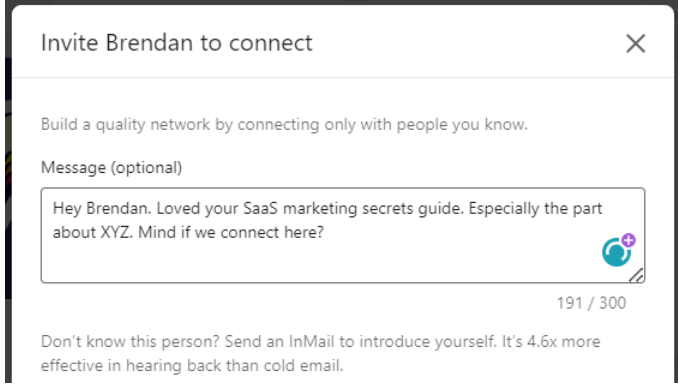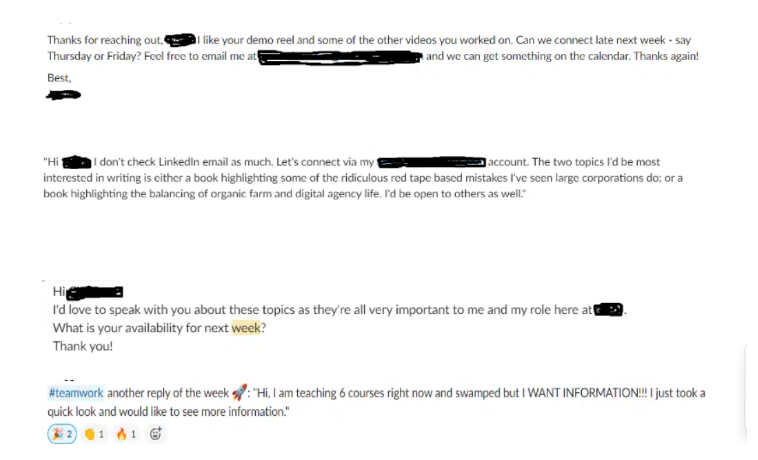
Many people ask: “Hey, Jack, how do you manage to get 1 lead a day?”
The short answer is:
“Use email + LinkedIn, good copywriting, and add lots of personalization to generate leads.”
But if you’re interested in learning our exact strategy for 1 lead a day, read on.
Our outbound sales strategy isn’t complex.
It just takes time, follow-ups, and knowing what people are replying to these days.
Thankfully, with 12 years of experience, we were able to develop and grow a strategy that works.
(Hint: This strategy starts sales conversations, and this in turn leads to phone calls and booked meetings. )
So if cold outreach isn’t working for you, try this approach.
With these lead generation strategies we have generated close to 7000 qualified sales leads for our clients within the past 24 months. If you’re interested in learning more, hop on a free 15-minute strategy call with us.
What are outbound sales strategies and how does it differ from inbound sales?
(If you already know the answer, feel free to skip this section and start reading about our strategy that guarantees new leads.)
Outbound sales and inbound sales are not the same.
Outbound sales teams use marketing strategies like:
- Cold calling
- Cold emailing
- Social selling
- Flyers
- Billboards
To reach potential customers.
The great thing about outbound leads is that you can immediately reach prospects.
For example, at Salesbread, about 98% of our clients receive their first lead within 48 hours after launching our outreach campaign.
Inbound marketing teams use things like:
- SEO
- Social media
- Website landing pages
- Content marketing
Inbound leads can take some time to generate. Stats have shown that inbound leads could take between 6 months to a year to really bring in.
We have found that it’s best to use both a mixure of inbound and outbound methods for higher conversion rates.
Salesbread uses these 3 outbound sales techniques.
Salesbread has 3 outbound sales strategies that we use for prospecting.
- LinkedIn outreach
- Cold email outreach. (We send out ultra personalized emails.)
- SMS outreach
This multi-channel approach ensures that the companies we partner with can get one lead a day and grow their businesses.
BUT our strategy revolves around two different targets, which are:
The end customer
This means that we will target the decision-maker directly.
So if you’re selling big-ticket items in the b2b space, it just makes more sense to go directly to the person in charge—the person who will decide whether to buy your item or not.
So we will create conversations and campaigns that go directly after the end customer.
Partnership campaigns
With partnership campaigns, we will find people who are already connected to the end customer. We will then create a campaign where we reach out to potential partners that can be a referral source for our clients.
Here’s an example:
If you’re selling a hosting services and you notice that a lot of your referrals come from fractional CTOs, then we’ll set up a referral campaign where we target fractional CTOs and get them to become a referral source.
Before we get into exactly how we do this, we would like you to know that both these campaign options have very similar outreach sales processes.
Here is how we do it
(Remember to first build an ultra-targeted list of your ideal customer profile. You can read more about list building in this article: How to Build a Sales Prospecting List in Any Industry. If your list isn’t perfect and super refined, you aren’t going to get qualified sales leads.)

Step 1: It all starts with a LinkedIn Connection invite.
Ideally, you would want to connect with those in your second-degree network.
(If you would like some connection request invite templates for inspiration, read this article.)
Why?
Well, think of it this way, you want to send invites out to potential clients who are actually engaged on LinkedIn.
Those who are active on this platform.
This is because if you send the invites to people who aren’t really using LinkedIn, you won’t get many people accepting your invites.
But…
You might be asking, “How do you know who is actually using LinkedIn and who isn’t?”
Well, there are 2 ways in which you can tell.
Number 1:
They already share a common connection with you, meaning they are already in your second-degree network.
What does this tell you?
Well, it tells you that they have already accepted people like you in the past.
It also tells you that they have a certain network size and that there is someone behind the LinkedIn profile who is likely to accept people who are relevant to them.
Number 2:
You can also connect with those who are outside of your second-degree network, but it’s important to check that they have recently posted something within the past 30 days.
Want to know how to do this?
Just pop into Sales Navigator, add in your search criteria by the filter section and type in 3rd degree.
You can then go to the “Spotlight” section and click “Posted on LinkedIn within the past 30 days.”
This will bring up people in your 3rd-degree connection who have been active on LinkedIn within the past month. ( See screenshots below:)



Step 2: What happens once that invite gets accepted? – Reply with more personalization…
Great! They accepted your LinkedIn connection request.
Now what?
This is where you are going to follow up by sending them an ultra-personalized message.
(At Salesbread we actually have a personalization expert SDR, whose only job is to actually research each prospect on the list and find something very specific to write about them in our messages.)
It is crucial that you add a custom intro sentence that compliments them on something they’ve shared.
You could say something like this:
“ By the way, I loved your webinar on XYZ; I would like to attend more.”
OR
“I see that you enjoy hiking. Where are the best hiking spots lately?”
You could also mention something that you both share in common, or you could ask a question about something interesting that they posted.
This outbound sales tactic allows for a “pattern interrupt,” which makes the prospect think, “Wait a minute, this isn’t just a spammer, but an actual person who is interested in me.”
This makes it more likely that they will reply to you.
Remember the 90/10 rule.
ALWAYS talk about the prospect 90% of the time and only 10% about yourself for context.
Another important factor when it comes to personalized messages is not to jump into your sales pitch immediately. This will put your target audience off any further conversations with you.
(Think about a cold call you received recently… Probably weren’t too happy with the sales rep trying to sell you insurance.)
Remember to keep it friendly.
Discuss the prospect’s pain points and how you think you could help each other in business.
Pro Tip:
Do not be like pushy salespeople. (No one enjoys being pushed into sales calls that they don’t want.)
If you are pushy, this will get your qualifying customer to cut the conversation within a matter of seconds, ending your lead generation sales cycle.
Step 3: Use a low-commitment CTA
We always send between 2-6 follow-up messages.
An important thing to remember is to also always ask for a meeting or a call in these messages.
Here are some ways to ask for a meeting:

What happens if the prospect does not accept the invite?
If they have not accepted the connection request after 21 – 30 days, withdraw the invitation from LinkedIn.
The reason?
This ensures that the prospect does not accumulate hundreds of pending LinkedIn invites.
You can also send them a cold email during the sales campaign if they are in your second-degree network.
In the email, make sure that your marketers also use personalization and mention a common connection that they share. Hopefully, this will get a reply.
You can even mention you sent them an invite on LinkedIn as a PS.
But even with email messaging, we will always send them a custom intro sentence (a real-time message, not some random automation) with a lot of personalization throughout.
This will help the reader realize that this email isn’t just some random spam mail.
This is an outbound sales process that we have used over the years, and it has always gotten us good reply rates, and high-quality leads.
Have a look at some of our most recent metrics:
You can read more about LinkedIn outreach stats here.

What happens if they don’t reply?
If the prospect hasn’t replied after two follow-up messages on LinkedIn, we will send them an email.
Where do we find their email address?
Well, most of the time, we will find it on their LinkedIn profile, or you could use a data provider, such as Apollo.io.
If they reply to the email, that’s a success, and hopefully, they will agree to a meeting.

What if they don’t reply to the email?
If they haven’t replied to the email, you can then send an SMS.
Where do we get their phone number from?
A phone number might be provided on the prospect’s LinkedIn profile if they share it with their first-degree connections.
The fact that they provided their contact information on their profile means that there is a good chance that they don’t mind hearing about work-related things from their first connections.
What if they still don’t reply even after an email and an SMS?
We will still send up to 5 follow-up cold emails and SMS messages.
Can you use this outbound prospecting for both LinkedIn and Cold Email?
Yes, you can. We use these same sales tactics when it comes to contacting the decision-maker (the end customer) and partnership campaigns.
Is this an effective outbound sales strategy?
Well, you tell us.
Here are some replies that we have received from using this approach on LinkedIn:
If you’re interested, check out some of our case studies that also go into detail on how we generated 20+ qualified leads a month for our clients. Whether they are in the SaaS space, startups or even Fortune 500 companies.

To Recap in a Nutshell
Make sure that you have an ultra-refined list of your target customer. If you are unsure how to build a list, read this: How to Build a Sales Prospecting List in Any Industry
- First, send a LinkedIn Connection Request – If they reply, Success
- Send 2- 6 follow-up messages until you get a reply.
- If they reply, success, if not, send 3 follow-up emails and SMS messages.
It’s that easy. If you would like to see what Salesbread can do for your company, hop on a free 15-minute strategy call.
(P.S If you would like a more indepth article on our exact process, read this article:
Why We Set Out to Build The Best Done-For-You Lead Generation Service
Need 1 lead per day? Get in touch…
If you’re interested, check out some of our case studies that also go into detail on how we generated 20+ qualified leads a month for our clients. Whether they are in the saas space, startups or even Fortune 500 companies.